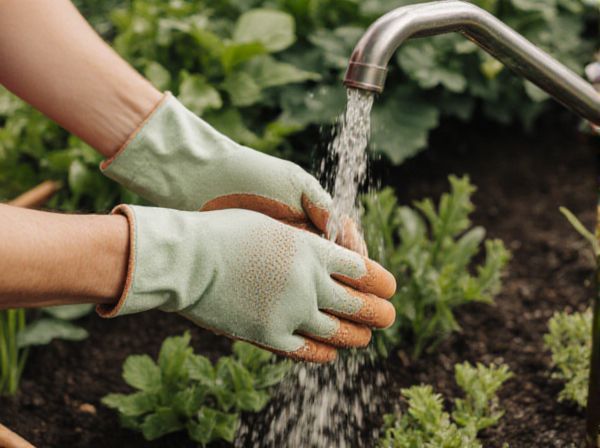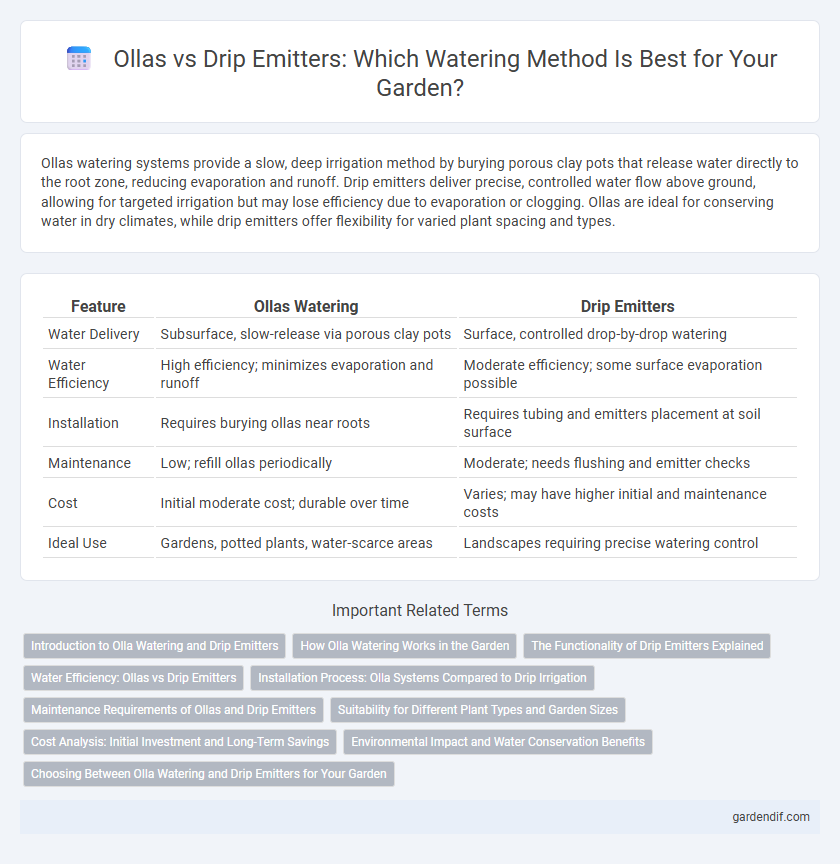
Ollas watering vs Drip emitters Illustration
Ollas watering systems provide a slow, deep irrigation method by burying porous clay pots that release water directly to the root zone, reducing evaporation and runoff. Drip emitters deliver precise, controlled water flow above ground, allowing for targeted irrigation but may lose efficiency due to evaporation or clogging. Ollas are ideal for conserving water in dry climates, while drip emitters offer flexibility for varied plant spacing and types.
Table of Comparison
| Feature | Ollas Watering | Drip Emitters |
|---|---|---|
| Water Delivery | Subsurface, slow-release via porous clay pots | Surface, controlled drop-by-drop watering |
| Water Efficiency | High efficiency; minimizes evaporation and runoff | Moderate efficiency; some surface evaporation possible |
| Installation | Requires burying ollas near roots | Requires tubing and emitters placement at soil surface |
| Maintenance | Low; refill ollas periodically | Moderate; needs flushing and emitter checks |
| Cost | Initial moderate cost; durable over time | Varies; may have higher initial and maintenance costs |
| Ideal Use | Gardens, potted plants, water-scarce areas | Landscapes requiring precise watering control |
Introduction to Olla Watering and Drip Emitters
Olla watering uses porous clay pots buried in soil to deliver water directly to plant roots through slow seepage, promoting deep root growth and reducing evaporation. Drip emitters distribute water through tubes with controlled droplets, targeting specific areas to maximize water efficiency and minimize runoff. Both irrigation methods enhance water conservation but differ in application technique and maintenance requirements.
How Olla Watering Works in the Garden
Ollas watering involves burying porous clay pots filled with water directly into the soil, allowing water to seep slowly and evenly to plant roots through capillary action. This efficient delivery reduces water waste by minimizing evaporation and runoff compared to drip emitters, which release water at a controlled rate above soil level. By maintaining consistent moisture around the root zone, ollas enhance plant health and conserve water in garden irrigation systems.
The Functionality of Drip Emitters Explained
Drip emitters release water slowly and precisely near the plant roots through a network of tubes, ensuring targeted hydration and reducing water waste. They offer adjustable flow rates, allowing gardeners to customize irrigation based on plant species and soil type. This system enhances efficient water delivery compared to traditional methods by minimizing evaporation and runoff.
Water Efficiency: Ollas vs Drip Emitters
Ollas use porous clay pots buried underground to release water slowly directly to plant roots, significantly reducing evaporation and runoff compared to drip emitters. Drip emitters deliver water at a controlled rate on the soil surface but often experience losses through evaporation and surface runoff, making them less water-efficient in hot, dry climates. Studies show ollas can reduce water use by up to 50% compared to traditional drip irrigation systems while maintaining healthy plant growth.
Installation Process: Olla Systems Compared to Drip Irrigation
Olla watering systems require burying porous clay pots near plant roots, providing slow, consistent moisture directly to the soil, which demands minimal tubing and fewer emitters during installation. Drip irrigation involves laying extensive tubing with multiple emitters spaced to cover the root zones, making the initial setup more complex and time-consuming. Ollas reduce installation labor by eliminating the need for precise emitter placement and pressure regulation common in drip systems, offering a simpler, water-efficient gardening solution.
Maintenance Requirements of Ollas and Drip Emitters
Ollas require minimal maintenance as they self-regulate water delivery through porous walls, reducing clogging and the need for frequent adjustments, unlike drip emitters which demand regular cleaning and inspections to prevent blockages and maintain consistent flow rates. Drip emitters often need filter replacements and system flushing to avoid mineral buildup and insect damage, increasing labor and upkeep costs. The low-maintenance nature of Ollas makes them a sustainable irrigation solution for long-term garden health with less time invested in system management.
Suitability for Different Plant Types and Garden Sizes
Ollas watering is highly suitable for deep-rooted plants and larger garden areas due to its slow, consistent moisture delivery that minimizes evaporation and runoff. Drip emitters offer precise water control ideal for diverse plant types, including shallow-rooted and container plants, making them effective for smaller or segmented garden layouts. Both systems enhance water efficiency but differ in adaptation, with Ollas favoring extensive planting zones and drip emitters excelling in targeted irrigation for mixed-species gardens.
Cost Analysis: Initial Investment and Long-Term Savings
Ollas irrigation systems require a higher initial investment compared to drip emitters due to the cost of porous clay vessels. However, ollas provide significant long-term savings by reducing water usage by up to 70% and minimizing plant stress, resulting in lower maintenance and replacement costs. In contrast, drip emitters have lower upfront costs but may incur higher expenses over time due to clogged lines, frequent maintenance, and less efficient water distribution.
Environmental Impact and Water Conservation Benefits
Ollas watering systems significantly reduce water waste by delivering moisture directly to plant roots through porous clay, minimizing evaporation and runoff compared to drip emitters. Drip emitters can lose water due to surface evaporation and clogged emitters, whereas ollas provide slow, steady hydration, enhancing soil moisture retention and reducing irrigation frequency. This targeted watering method promotes sustainable water conservation and lowers environmental impact in drought-prone or water-scarce areas.
Choosing Between Olla Watering and Drip Emitters for Your Garden
Olla watering systems provide deep, slow water delivery directly to plant roots, reducing evaporation and promoting efficient water use in xeriscaping and container gardens. Drip emitters offer precise control over water distribution with adjustable flow rates, making them ideal for diverse plant types and complex garden layouts. Choosing between ollas and drip emitters depends on garden size, plant species, water conservation goals, and maintenance preferences.
Ollas watering vs Drip emitters Infographic

 gardendif.com
gardendif.com